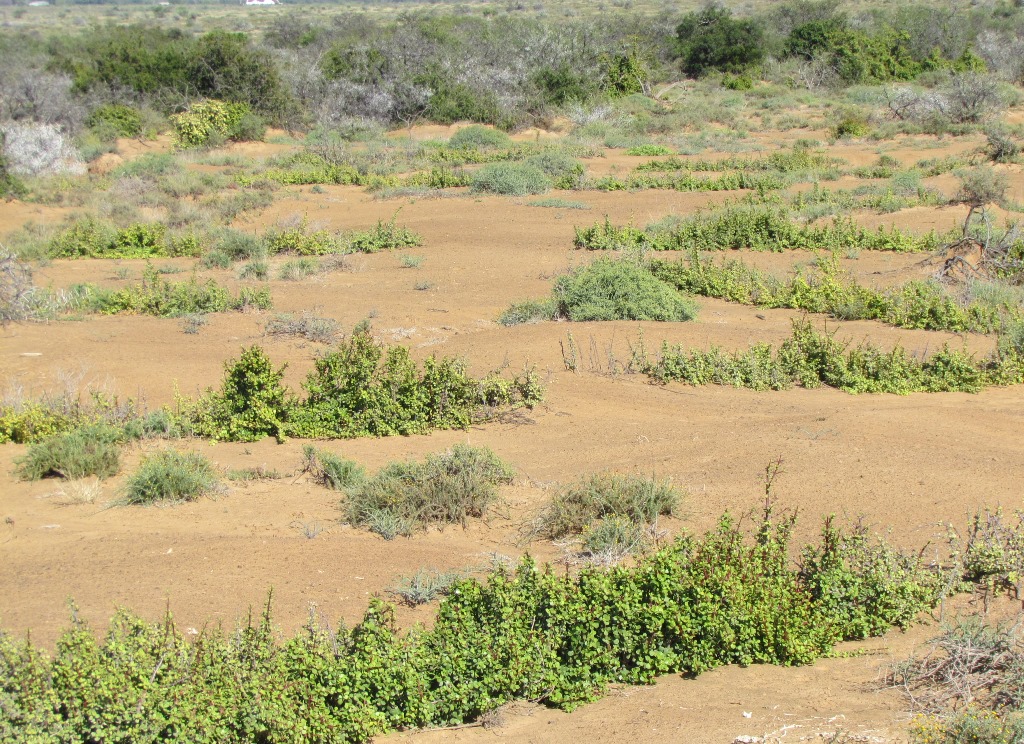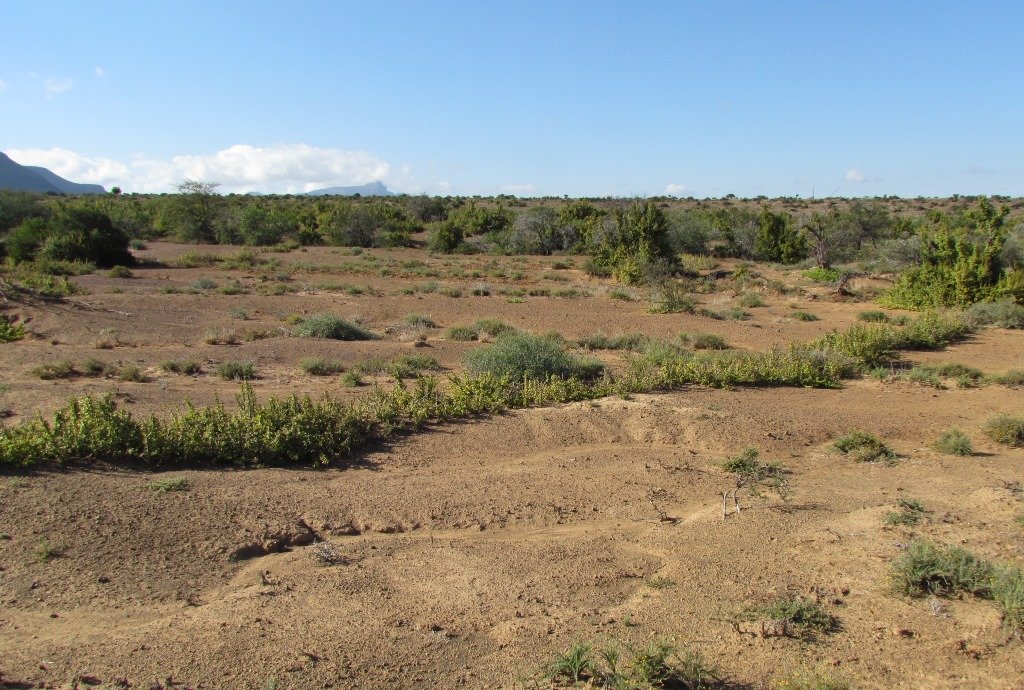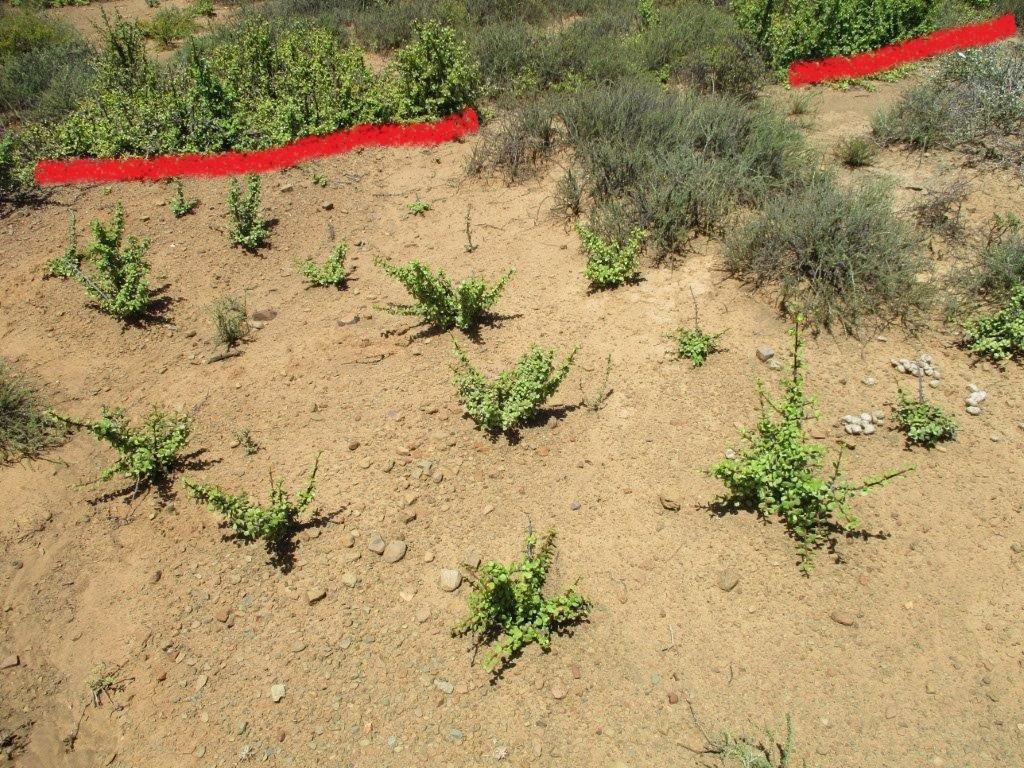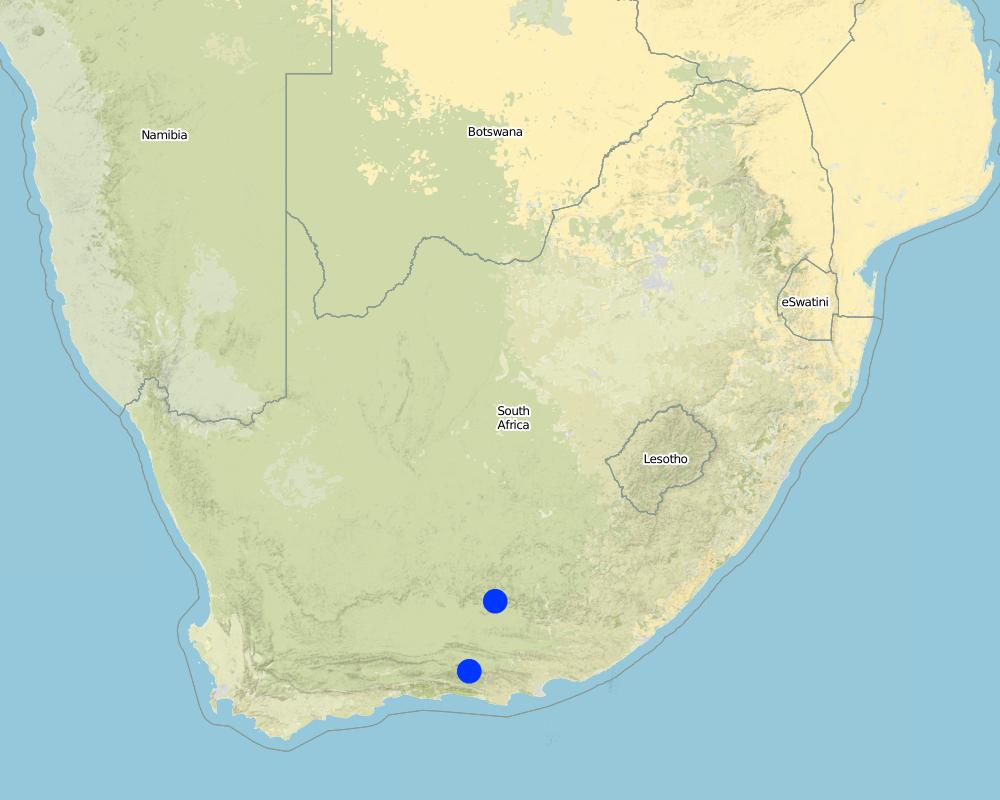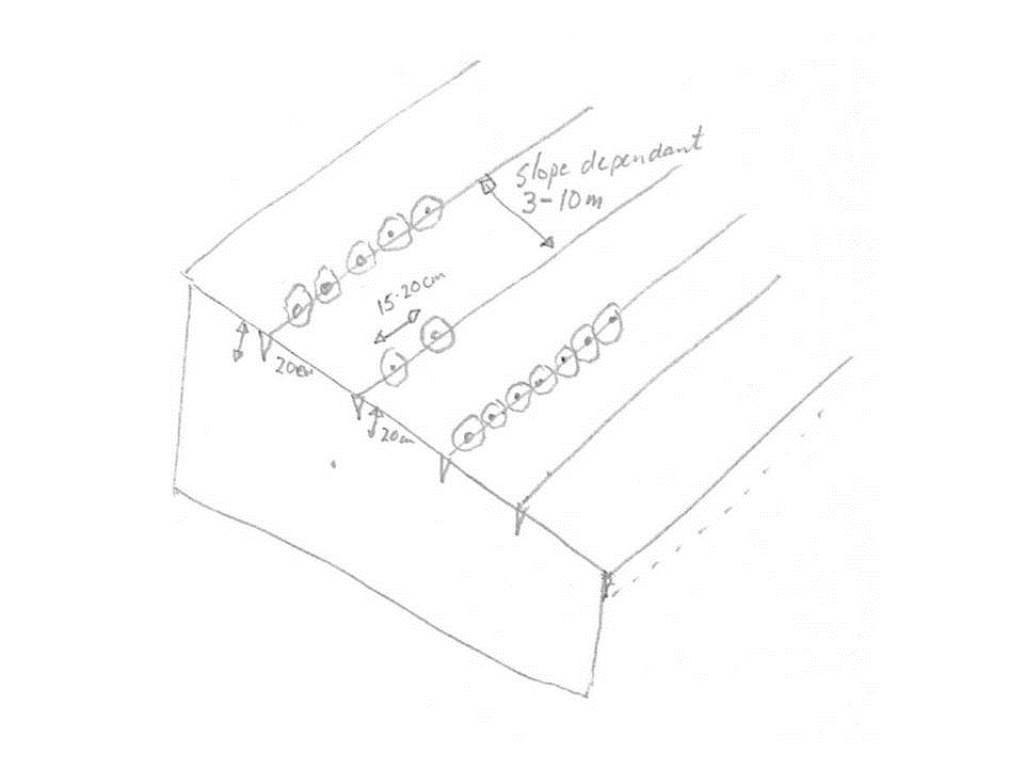Spekboom (Portulacaria afra) planting within riplines for thicket biome restoration [South Africa]
- Creation:
- Update:
- Compiler: Dirk Pretorius
- Editor: –
- Reviewers: Yacime Khadraoui, Maximilian Knoll, Rima Mekdaschi Studer, Alexandra Gavilano
Spekboom planting on contours
technologies_3614 - South Africa
- Full summary as PDF
- Full summary as PDF for print
- Full summary in the browser
- Full summary (unformatted)
- Spekboom (Portulacaria afra) planting within riplines for thicket biome restoration: May 19, 2018 (inactive)
- Spekboom (Portulacaria afra) planting within riplines for thicket biome restoration: June 20, 2019 (inactive)
- Spekboom (Portulacaria afra) planting within riplines for thicket biome restoration: Nov. 2, 2021 (public)
View sections
Expand all Collapse all1. General information
1.2 Contact details of resource persons and institutions involved in the assessment and documentation of the Technology
Name of project which facilitated the documentation/ evaluation of the Technology (if relevant)
Working on Ecosystems (Natural Resource Management Programmes – DEA, South Africa)Name of the institution(s) which facilitated the documentation/ evaluation of the Technology (if relevant)
SMC Synergy (SMC Synergy) - South Africa1.3 Conditions regarding the use of data documented through WOCAT
The compiler and key resource person(s) accept the conditions regarding the use of data documented through WOCAT:
Yes
1.4 Declaration on sustainability of the described Technology
Is the Technology described here problematic with regard to land degradation, so that it cannot be declared a sustainable land management technology?
No
1.5 Reference to Questionnaire(s) on SLM Approaches (documented using WOCAT)
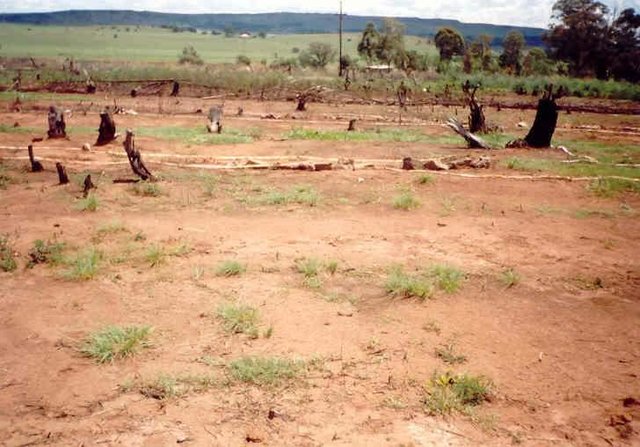
Working for Water [South Africa]
Government funded restoration/rehabilitation initiative as part of Working for Water project. Aim was to eradicate alien invasive.
- Compiler: Klaus Kellner
2. Description of the SLM Technology
2.1 Short description of the Technology
Definition of the Technology:
The restoration of the thicket biome in the Eastern Cape is assisted by planting ‘spekboom’ (elephant bush) (Portulacaria afra), an indigenous succulent plant within contour lines/riplines on degraded hillslopes. The increased vegetation cover reduces runoff and soil loss.
2.2 Detailed description of the Technology
Description:
Due to severe land degradation over many decades of goat farming, the restoration of the so-called ‘thicket biome’ is taking place on a large scale in the Baviaanskloof Nature Reserve and Camdeboo National Park in the Eastern Cape of South Africa. The restoration projects have been introduced in parts of the thicket biome that receive 350 to 500 mm annual average rainfall. The main direct cause of degradation is overgrazing/browsing by goats (Boer and Angora) over the past 100 years. The overutilization of vegetation occurs mainly on valley bottoms and footslopes in mountainous areas where relatively fertile soils occur. This has resulted in large expanses of open vegetation canopy under which a high degree of runoff occurs - and subsequent soil loss leading to increased sediment loads in downstream drainage systems. The thicket biome vegetation (especially spekboom) is well known for its ability to sequester large amounts of carbon and therefore help towards mitigating climate change. The improved vegetation cover also contributes towards an increase in biodiversity, and therefore has a positive impact on tourism also. Establishment of spekboom in riplines can be used in combination with other technologies e.g. brush packing (laying cut bush on the soil surface), silt fences (low barriers across the slope) or fibre rolls. This technology can be employed in any similar semi-arid environment to restore degraded catchments - using locally appropriate plant species.
After identification of sites to be rehabilitated, this is followed by the identification of suitable sources of plant material for transplantation at the rehabilitation areas. In the case of the project in the Eastern Cape, spekboom cuttings of 30 to 50 cm in length were taken from existing stands, then left for one to two weeks in the sun to dry slightly before being transplanted in the rehabilitation sites. Care must be taken not to over-harvest healthy spekboom stands - not more than 30% should be removed.
Riplines need to be created along the contour by means of mechanisation or manual labour. Riplines should be between 3 and 10 meter apart - depending on the slope (closer on steep slopes) - 10 to 20 cm deep and just wide enough to plant the spekboom cuttings to a depth of at least 10 cm. Cuttings are planted between 15 to 20 cm apart within the ripline, so as to form a continuous barrier/sediment trap along the contour. The ripline promotes water infiltration into the rootzone of the cuttings. Cuttings need to be firmed-in with soil dug from the ripline. Watering the spekboom after planting is recommended – if possible. Brush packing (brush packing with thorny biomass to prevent grazing and provide a micro-climate for grass seed to germinate and establish) between riplines with local woody material (if available locally, and preferably thorny branches) is recommended to provide protection against grazing and to create a micro-climate for vegetation growth. In between riplines, silt fences or fibre rolls can be used to slow water runoff and to trap sediment. Maintenance includes the replanting of cuttings where mortality occurred.
2.3 Photos of the Technology
2.5 Country/ region/ locations where the Technology has been applied and which are covered by this assessment
Country:
South Africa
Region/ State/ Province:
Eastern Cape
Specify the spread of the Technology:
- applied at specific points/ concentrated on a small area
Comments:
Only implemented on degraded Thicket Biome areas on low to moderate slopes.
Map
×2.6 Date of implementation
Indicate year of implementation:
2010
If precise year is not known, indicate approximate date:
- less than 10 years ago (recently)
2.7 Introduction of the Technology
Specify how the Technology was introduced:
- during experiments/ research
Comments (type of project, etc.):
Research conducted by P Burdett at Camdeboo National Park.
3. Classification of the SLM Technology
3.1 Main purpose(s) of the Technology
- reduce, prevent, restore land degradation
- conserve ecosystem
- protect a watershed/ downstream areas – in combination with other Technologies
- preserve/ improve biodiversity
- adapt to climate change/ extremes and its impacts
- mitigate climate change and its impacts
- create beneficial economic impact
3.2 Current land use type(s) where the Technology is applied

Grazing land
- Wildlife in nature reserves
- Various game species
Comments:
Main animal species and products: Various game species.
Number of growing seasons per year: 1
Livestock density: Only wildlife - low density
3.4 Water supply
Water supply for the land on which the Technology is applied:
- rainfed
3.5 SLM group to which the Technology belongs
- improved ground/ vegetation cover
- water harvesting
- surface water management (spring, river, lakes, sea)
3.6 SLM measures comprising the Technology

vegetative measures
- V1: Tree and shrub cover

structural measures
- S6: Walls, barriers, palisades, fences
3.7 Main types of land degradation addressed by the Technology

soil erosion by water
- Wt: loss of topsoil/ surface erosion
- Wg: gully erosion/ gullying
- Wo: offsite degradation effects

physical soil deterioration
- Pc: compaction
- Pk: slaking and crusting
- Pi: soil sealing

biological degradation
- Bc: reduction of vegetation cover
- Bh: loss of habitats
- Bq: quantity/ biomass decline

water degradation
- Hs: change in quantity of surface water
- Hg: change in groundwater/aquifer level
- Hp: decline of surface water quality
3.8 Prevention, reduction, or restoration of land degradation
Specify the goal of the Technology with regard to land degradation:
- restore/ rehabilitate severely degraded land
Comments:
Overgrazing by goats over the past 100 years – land has been purchased from private landowners since 1987.
4. Technical specifications, implementation activities, inputs, and costs
4.1 Technical drawing of the Technology
Technical specifications (related to technical drawing):
Spekboom cuttings (30 - 50 cm in length and 1 to 3 cm diameter) are cut from existing stands. The riplines are created by labourer (soil on downhill side of line) on contours with the spacing between lines a function of the slope (3 metres apart on 10 - 15 degree slopes and 6 to 10 metres apart on 5 to 10 degree slopes). The cuttings are planted 15 to 20 cm apart in the riplines at a depth of around 10 cm.
Riplines 10cm deep – as long as the bare patches that need rehabilitation – labourers also use picks.
Author:
J Buckle
Date:
21/02/2018
4.2 General information regarding the calculation of inputs and costs
Specify how costs and inputs were calculated:
- per Technology area
Indicate size and area unit:
1 ha
other/ national currency (specify):
Rand
If relevant, indicate exchange rate from USD to local currency (e.g. 1 USD = 79.9 Brazilian Real): 1 USD =:
12.0
Indicate average wage cost of hired labour per day:
140
4.3 Establishment activities
| Activity | Timing (season) | |
|---|---|---|
| 1. | Creation of riplines (unskilled manual labour) | during wet season |
| 2. | Collection of Spekboom cuttings | during wet season |
| 3. | Transport of cuttings to planting site | during wet season |
| 4. | Planting of cuttings in riplines | during wet season |
| 5. | Watering of cuttings | during wet season |
4.4 Costs and inputs needed for establishment
| Specify input | Unit | Quantity | Costs per Unit | Total costs per input | % of costs borne by land users | |
|---|---|---|---|---|---|---|
| Labour | Unskilled labour (including transport) | per day | 20.0 | 240.0 | 4800.0 | 100.0 |
| Equipment | Picks, spades, wheel barrow, bow saw and pruning shears (renting equipment) | per day | 20.0 | 20.0 | 400.0 | 100.0 |
| Plant material | Planting material is free | |||||
| Plant material | Planting material is free | |||||
| Other | Management (including transport) | per day | 2.0 | 600.0 | 1200.0 | 100.0 |
| Total costs for establishment of the Technology | 6400.0 | |||||
| Total costs for establishment of the Technology in USD | 533.33 | |||||
4.5 Maintenance/ recurrent activities
| Activity | Timing/ frequency | |
|---|---|---|
| 1. | Replant cuttings where mortality occurs | 6 to 8 months after planting |
4.6 Costs and inputs needed for maintenance/ recurrent activities (per year)
| Specify input | Unit | Quantity | Costs per Unit | Total costs per input | % of costs borne by land users | |
|---|---|---|---|---|---|---|
| Labour | Replanting of cuttings (unskilled labour - including transport) | per day | 10.0 | 240.0 | 2400.0 | 100.0 |
| Other | Management (including transport) | per day | 1.0 | 600.0 | 600.0 | 100.0 |
| Total costs for maintenance of the Technology | 3000.0 | |||||
| Total costs for maintenance of the Technology in USD | 250.0 | |||||
4.7 Most important factors affecting the costs
Describe the most determinate factors affecting the costs:
Soil hardness, labour cost and distance to rehabilitation site.
5. Natural and human environment
5.1 Climate
Annual rainfall
- < 250 mm
- 251-500 mm
- 501-750 mm
- 751-1,000 mm
- 1,001-1,500 mm
- 1,501-2,000 mm
- 2,001-3,000 mm
- 3,001-4,000 mm
- > 4,000 mm
Specify average annual rainfall (if known), in mm:
350.00
Specifications/ comments on rainfall:
Summer thunderstorms
Agro-climatic zone
- semi-arid
Harsh hot summers and very cold winters
5.2 Topography
Slopes on average:
- flat (0-2%)
- gentle (3-5%)
- moderate (6-10%)
- rolling (11-15%)
- hilly (16-30%)
- steep (31-60%)
- very steep (>60%)
Landforms:
- plateau/plains
- ridges
- mountain slopes
- hill slopes
- footslopes
- valley floors
Altitudinal zone:
- 0-100 m a.s.l.
- 101-500 m a.s.l.
- 501-1,000 m a.s.l.
- 1,001-1,500 m a.s.l.
- 1,501-2,000 m a.s.l.
- 2,001-2,500 m a.s.l.
- 2,501-3,000 m a.s.l.
- 3,001-4,000 m a.s.l.
- > 4,000 m a.s.l.
Indicate if the Technology is specifically applied in:
- convex situations
5.3 Soils
Soil depth on average:
- very shallow (0-20 cm)
- shallow (21-50 cm)
- moderately deep (51-80 cm)
- deep (81-120 cm)
- very deep (> 120 cm)
Soil texture (topsoil):
- medium (loamy, silty)
- fine/ heavy (clay)
Soil texture (> 20 cm below surface):
- medium (loamy, silty)
Topsoil organic matter:
- low (<1%)
5.4 Water availability and quality
Ground water table:
> 50 m
Availability of surface water:
poor/ none
Water quality (untreated):
for agricultural use only (irrigation)
Is water salinity a problem?
Yes
Specify:
High sodium content in the parent sedimentary rock
Is flooding of the area occurring?
Yes
5.5 Biodiversity
Species diversity:
- medium
Habitat diversity:
- medium
5.6 Characteristics of land users applying the Technology
other (specify):
Government conservation areas
Market orientation of production system:
- commercial/ market
Off-farm income:
- > 50% of all income
Relative level of wealth:
- average
Individuals or groups:
- employee (company, government)
Level of mechanization:
- manual work
Gender:
- women
- men
Age of land users:
- youth
- middle-aged
Indicate other relevant characteristics of the land users:
Rehabilitation mainly on State-owned conservation areas - can be replicated on private land.
5.7 Average area of land used by land users applying the Technology
- < 0.5 ha
- 0.5-1 ha
- 1-2 ha
- 2-5 ha
- 5-15 ha
- 15-50 ha
- 50-100 ha
- 100-500 ha
- 500-1,000 ha
- 1,000-10,000 ha
- > 10,000 ha
Is this considered small-, medium- or large-scale (referring to local context)?
- large-scale
5.8 Land ownership, land use rights, and water use rights
Land ownership:
- state
Land use rights:
- communal (organized)
- Conservation areas
- Conservation areas
5.9 Access to services and infrastructure
health:
- poor
- moderate
- good
education:
- poor
- moderate
- good
technical assistance:
- poor
- moderate
- good
employment (e.g. off-farm):
- poor
- moderate
- good
markets:
- poor
- moderate
- good
energy:
- poor
- moderate
- good
roads and transport:
- poor
- moderate
- good
drinking water and sanitation:
- poor
- moderate
- good
financial services:
- poor
- moderate
- good
6. Impacts and concluding statements
6.1 On-site impacts the Technology has shown
Socio-economic impacts
Production
fodder production
fodder quality
Socio-cultural impacts
recreational opportunities
SLM/ land degradation knowledge
Ecological impacts
Water cycle/ runoff
water quantity
water quality
harvesting/ collection of water
surface runoff
Soil
soil moisture
soil cover
soil loss
soil organic matter/ below ground C
Biodiversity: vegetation, animals
Vegetation cover
habitat diversity
Climate and disaster risk reduction
flood impacts
emission of carbon and greenhouse gases
micro-climate
6.2 Off-site impacts the Technology has shown
downstream flooding
downstream siltation
impact of greenhouse gases
Specify assessment of off-site impacts (measurements):
The cumulative effect of large areas planted with Spekboom will have a huge offsite impact especially after a few years.
6.3 Exposure and sensitivity of the Technology to gradual climate change and climate-related extremes/ disasters (as perceived by land users)
Gradual climate change
Gradual climate change
| Season | increase or decrease | How does the Technology cope with it? | |
|---|---|---|---|
| annual temperature | increase | well | |
| annual rainfall | decrease | moderately |
Climate-related extremes (disasters)
Meteorological disasters
| How does the Technology cope with it? | |
|---|---|
| local thunderstorm | very well |
| local hailstorm | not well |
Climatological disasters
| How does the Technology cope with it? | |
|---|---|
| cold wave | not well |
Hydrological disasters
| How does the Technology cope with it? | |
|---|---|
| flash flood | moderately |
Biological disasters
| How does the Technology cope with it? | |
|---|---|
| epidemic diseases | not well |
6.4 Cost-benefit analysis
How do the benefits compare with the establishment costs (from land users’ perspective)?
Short-term returns:
slightly negative
Long-term returns:
positive
How do the benefits compare with the maintenance/ recurrent costs (from land users' perspective)?
Short-term returns:
slightly negative
Long-term returns:
positive
6.5 Adoption of the Technology
- 1-10%
Of all those who have adopted the Technology, how many did so spontaneously, i.e. without receiving any material incentives/ payments?
- 0-10%
6.6 Adaptation
Has the Technology been modified recently to adapt to changing conditions?
Yes
other (specify):
Improved planting techniques
Specify adaptation of the Technology (design, material/ species, etc.):
Planting of cuttings with established roots from the mother plant and creation of small notches a the cutting to stimulate root growth.
6.7 Strengths/ advantages/ opportunities of the Technology
| Strengths/ advantages/ opportunities in the land user’s view |
|---|
| A long-term cost-effective technique to rehabilitate badly degraded thicket vegetation. |
| Creates temporary work for poor local communities. |
| Reduces sediment load in streams and rivers. |
| Strengths/ advantages/ opportunities in the compiler’s or other key resource person’s view |
|---|
| Spekboom sequesters large quantities of carbon and therefore contributes over the long term to climate change mitigation. |
| Downstream benefits on water quality. |
6.8 Weaknesses/ disadvantages/ risks of the Technology and ways of overcoming them
| Weaknesses/ disadvantages/ risks in the land user’s view | How can they be overcome? |
|---|---|
| Labour intensive - not viable if not subsidised by Government. | Reduce manual labour - mechanise the creation of riplines. |
| Newly established spekboom stands vulnerable to browsing. | Fence rehabilitated areas. |
| Newly established spekboom stands vulnerable to drought and frost. | Timing of planting in wet/warm season |
7. References and links
7.1 Methods/ sources of information
- interviews with SLM specialists/ experts
1
When were the data compiled (in the field)?
21/02/2018
7.3 Links to relevant online information
Title/ description:
Spekboom foundation
URL:
http://www.spekboomfoundation.co.za/about.html
Links and modules
Expand all Collapse allLinks

Working for Water [South Africa]
Government funded restoration/rehabilitation initiative as part of Working for Water project. Aim was to eradicate alien invasive.
- Compiler: Klaus Kellner
Modules
No modules


